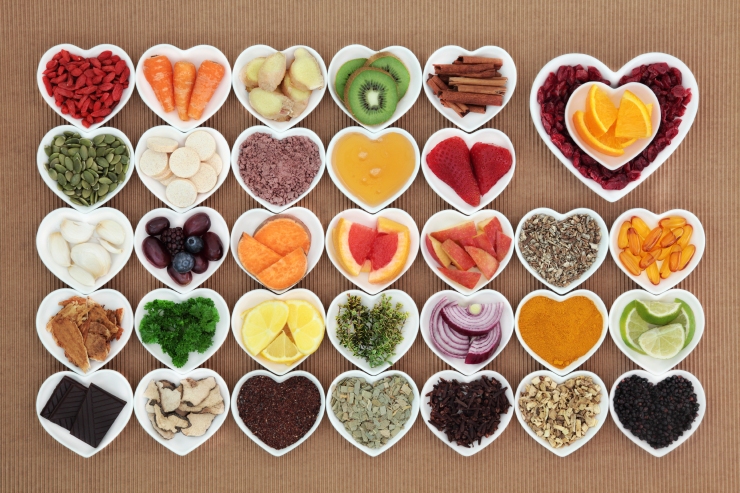February is American Heart Month, a time to focus on your heart and health. Generally speaking, a heart-healthy diet is one that’s modeled after how the people in the Mediterranean region eat. That means plenty of fruits and vegetables, lean meats, seafood, healthy oils, whole grains and an occasional glass of wine. People in the Mediterranean region also tend to walk more, linger over their meals and have close bonds among family and the community. I simply couldn’t let the month go by without putting together a list of my favorite heart-healthy items – things you can easily find here in the good ol’ U.S. of A. Let’s see if you agree:
- Oatmeal: This fiber-rich breakfast staple is a heart-healthy powerhouse. The beta-glucan in oatmeal acts like a magnet to cholesterol in the bloodstream and flushing it away. Oatmeal is also really inexpensive and versatile. Not only does it make for a hearty breakfast (check out this recipe for my perfect oatmeal), but in my family also use it in place of breadcrumbs for our favorite meatloaf recipe.
- Beans: I think of beans as nature’s perfect food. It’s a vegetable and a protein, has little fat and calories yet provides numerous vitamins and minerals. The little legume – also called a pulse food – is perfect for pregnant and breastfeeding moms as it provides folic acid, iron and fiber. The United Nations called 2016 The Year Of The Pulses, and my favorite way to get more pulses is by eating black beans with tomatoes and a sprinkling of reduced fat cheese. Yum!
- Nuts: Yes nuts have fat, but it’s primarily heart-healthy monounsaturated fats. Nuts also provide fiber (are you noticing a theme here with this amazing nutrient and heart health?), and protein to keep you satisfied. I eat pretty much all kinds of nuts, but my favorites are lightly-salted almonds and peanuts. I even make my own peanut butter after being inspired by this post from a fellow dietitian blogger. Rarely does a day go by without having a dab of my homemade PB on an apple or a piece of toast.
- Salmon: I don’t eat salmon very much at home, as certain family members have an aversion to its smell (not an uncommon turnoff, I’ve learned). But this pink fish is my go-to source for another kind of heart-healthy fat: EPA and DHA omega-3s (disclosure: The Global Organization for EPA and DHA omega-3s is a client, but they did not ask me to write this post). These marine-based long-chain omega-3s – not to be confused with plant-based ALA found in certain nuts, seeds and other foods – have been shown to support cardiovascular health, as well as brain health and other possible benefits (more science needs to be done). If you’re a health profession wonk like me and want to learn more about the science behind EPA and DHA for heart health, read this white paper. Or, you can get some basic information at AlwaysOmega3s.com. Salmon is great on the grill (and leaves the smell outside) and is also really convenient – and inexpensive – when you buy it canned or in pouches.
- Grape Juice: We all know that red wine can be good for the heart, but the same goes for your childhood favorite: 100% grape juice – the naturally sweet purple stuff made with Concord grapes (disclosure: I also work with Welch’s, but again, they did not ask me to write this. I just really like this juice and find the science compelling.) The Concord is a unique grape – it has a thick skin with a fleshy middle that literally pops out of its skin when you squeeze it. It also has crunchy seeds. Both the skin and the seeds are concentrated sources of polyphenols, or plant nutrients associated with health benefits including heart health and healthy circulation. You can’t find fresh Concords very easily outside of the fall season, but drinking 100% grape juice made with Concord grapes is really your best option for reaping the benefits. As you would with nuts – and frankly, all of the items mentioned above – portion size is important. Just ½ cup, or 4 oz., of 100% grape juice is enough to supply one serving of fruit. Remember also that 100% fruit juice (which, by its nature contains no added sugars but only natural fruit sugars) should be a complement to, not a replacement for, whole fruits. That is why…
- Fruits and Vegetables – all varieties also make my list. I eat vegetables pretty liberally, as they provide tons of vitamins, fiber and nutrients for very few calories. I eat plenty of fresh fruit as well – sprinkled on my oatmeal, mixed in a smoothie or as a snack on its own. Fruits and vegetables should take up roughly half your diet. My favorites change by the season but these days I’m really into jicama, snap peas and clementines.
The best thing about the foods I’ve listed here is that they’re all easily accessible, found in your local grocery store, and are typically inexpensive. Eating a heart-healthy diet need not only be for those who can afford luxuries. Don’t forget to couple all this healthy eating with being active. Walking, playing, dancing – all of that is free!!!
Tell me your favorite ways to be heart healthy by commenting below.
Disclosure: I was not asked to write this post by any of my clients or colleagues, nor was I compensated to do so. I only work with companies and organizations that I believe in and that place a high priority on science and research. All opinions expressed are mine and mine alone.



Published by